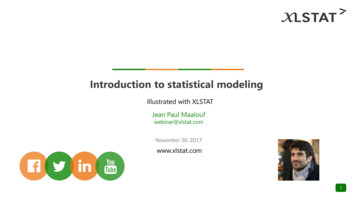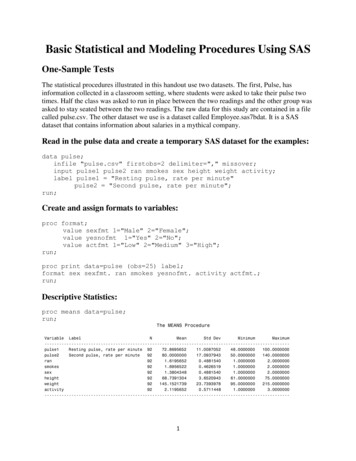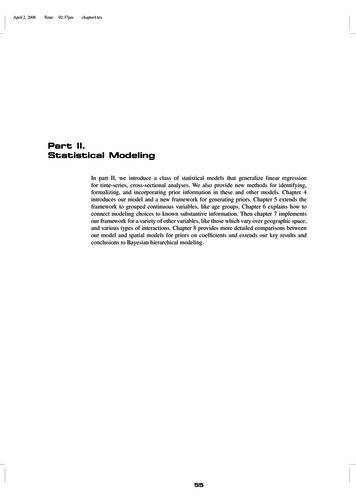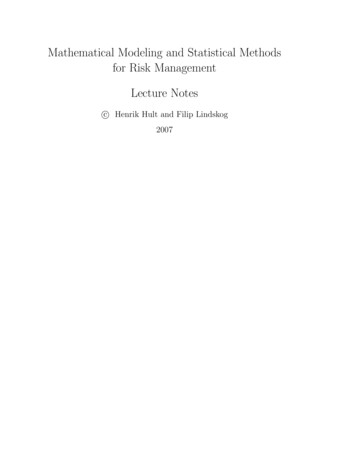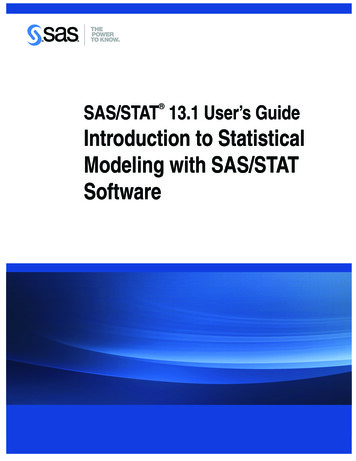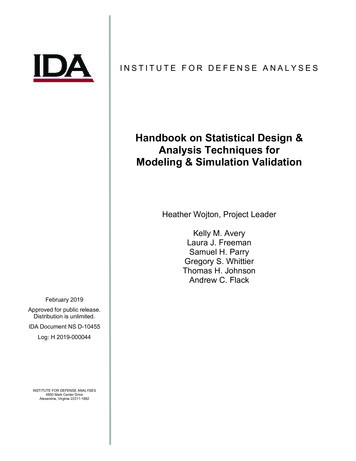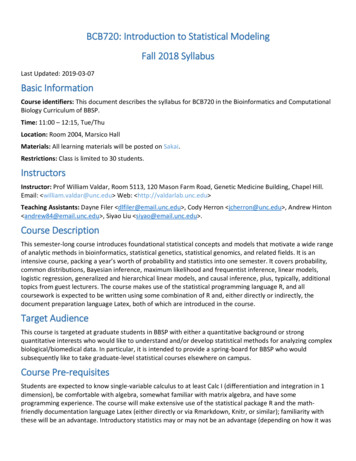
Transcription
BCB720: Introduction to Statistical ModelingFall 2018 SyllabusLast Updated: 2019-03-07Basic InformationCourse identifiers: This document describes the syllabus for BCB720 in the Bioinformatics and ComputationalBiology Curriculum of BBSP.Time: 11:00 – 12:15, Tue/ThuLocation: Room 2004, Marsico HallMaterials: All learning materials will be posted on Sakai.Restrictions: Class is limited to 30 students.InstructorsInstructor: Prof William Valdar, Room 5113, 120 Mason Farm Road, Genetic Medicine Building, Chapel Hill.Email: william.valdar@unc.edu Web: http://valdarlab.unc.edu Teaching Assistants: Dayne Filer dlfiler@email.unc.edu , Cody Herron jcherron@unc.edu , Andrew Hinton andrew84@email.unc.edu , Siyao Liu siyao@email.unc.edu .Course DescriptionThis semester-long course introduces foundational statistical concepts and models that motivate a wide rangeof analytic methods in bioinformatics, statistical genetics, statistical genomics, and related fields. It is anintensive course, packing a year’s worth of probability and statistics into one semester. It covers probability,common distributions, Bayesian inference, maximum likelihood and frequentist inference, linear models,logistic regression, generalized and hierarchical linear models, and causal inference, plus, typically, additionaltopics from guest lecturers. The course makes use of the statistical programming language R, and allcoursework is expected to be written using some combination of R and, either directly or indirectly, thedocument preparation language Latex, both of which are introduced in the course.Target AudienceThis course is targeted at graduate students in BBSP with either a quantitative background or strongquantitative interests who would like to understand and/or develop statistical methods for analyzing complexbiological/biomedical data. In particular, it is intended to provide a spring-board for BBSP who wouldsubsequently like to take graduate-level statistical courses elsewhere on campus.Course Pre-requisitesStudents are expected to know single-variable calculus to at least Calc I (differentiation and integration in 1dimension), be comfortable with algebra, somewhat familiar with matrix algebra, and have someprogramming experience. The course will make extensive use of the statistical package R and the mathfriendly documentation language Latex (either directly or via Rmarkdown, Knitr, or similar); familiarity withthese will be an advantage. Introductory statistics may or may not be an advantage (depending on how it was
taught), but is not assumed. The course will include some material on partial differentiation of multiparameterfunctions, and so familiarity with this will help also.RestrictionsThe course is open to all graduate students of the Biological and Biomedical Sciences Program (BBSP) at UNCChapel Hill. Other students, staff, or faculty may attend for credit, on an auditor basis or informally only if They have prior permission from the lead instructor, and There is space: that is, if they are not taking up a spot that would be otherwise used by a non-auditing(ie, full credit) BBSP student.Moreover, graduate students from the Department of Biostatistics (BIOS) or the Department of Statistics andOperations Research (STOR) may audit only, and may not receive credit for this course.Course Goals and Key Learning Objectives1.Probability and distributions2.Properties of random variables3.Bayesian and frequentist approaches to statistical inference4.Hypothesis testing5.Linear models6.Generalized linear models7.Hierarchical/mixed models8.Basic multidimensional analysis (PCA, clustering)Course RequirementsTo obtain full credit, students must attend at least 80% of the lectures, complete all homeworks, and achieveat least a passing overall grade. Homeworks should be written using Latex typesetting, either directly orthrough, eg, Rmarkdown, Knitr, etc.DatesHomework: Assignments will typically be distributed on Wednesdays, with a deadline for electronicsubmission on the Friday of the following week. Also, anonymous student evaluations, required for 5% of thecourse marks, will be distributed for completion on Sakai within approximately a week of course completion.Students will have a week to complete the student evaluation.Drop date: The latest date for dropping the course, or, for example, switching to auditor status, is October 16,2018 if using the web registration system or November 21, 2018 if going through John Cornett / officialchannels. Related: The last day to reduce course load in order to have tuition adjusted is September 4, 2018.Details at https://registrar.unc.edu/events/.GradesGrades for the course (F,L,P,H) will be based on performance in the homeworks and on completion of thecourse evaluation. Specifically, the homeworks collectively account for 95% of the course marks (see below),and completion of the anonymous evaluation accounts for the remaining 5%. There is no final exam.
Homeworks: Each homework will include multiple questions each providing a stated maximum number ofpoints. The total number of points achieved by a student divided by the total possible will be scaled to therange 0 to 95 and used as the percentage of the grade arising from coursework. A homework that is handed inlate, without prior agreement of the instructor, will have points in a manner described on the rubric of thehomework sheet.Grade conversion: Total course percentages will be mapped to HPLF course grades based on the followinggrade boundaries: H 90 %, P 75 %, L 60 %, F 60%. Specifically, in some years the instructor may useslightly adjusted boundaries if it is seems necessary to recalibrate against unintended changes in homeworkdifficulty, etc. For students whose curriculum requires letter grades, grade boundaries will be based on theboundaries: A 90 %, B 80 %, C 70 %, D 60 %, F 60%.Course Policies Students must attend the entire duration of at least 80% of the lectures unless they have permission ofthe lead instructor to do otherwise. Students are expected to be prompt, polite, collaborative when(and only when) asked, and to answer questions in class. Failure to hand in a homework on time without reasonable justification (eg, sickness) will result inautomatic loss of 10% of that homework’s maximum allowable points for each day over the deadline. Electronic devices should be stowed away during class unless otherwise instructed. Most classes arepen-and-paper based.Time Table (preliminary)Key: (C) Students should bring (or be prepared to share) a laptop. *Subject to change.Week1234DateLec #Instr.DescriptionTue-21-Aug1 (C)(TA)Introduction to R and LatexThu-23-Aug2WVSet theory and probabilityTue-28-Aug3WVConditional ProbabilityThu-30-Aug4WVDistribution, Mass and Density functionsTue-04-Sep5WVExpectation and VarianceThu-06-Sep6WVDiscrete distributionsTue-11-Sep7WVContinuous distributionsThu-13-Sep5678Tue-18-Sep8WVMixtures and transformationsThu-20-Sep9WVBayesian quentist behaviorTue-02-Oct12WVConfidence intervalsThu-04-Oct13WVHypothesis testing: conceptsTue-09-Oct14WVHypothesis testing: Wald, score, LRTTue-16-OctREADING DAY15WVThu-18-Oct101234CANCELLED DUE TO WEATHERThu-11-Oct9HWPower and multiple testingFALL BREAKTue-23-Oct16WVFWER and FDRThu-25-Oct17WVTwo-group tests: permutation and t-test567
11121314Tue-30-Oct18WVLinear modelsThu-01-Nov19WVLinear models: estimationTue-06-NovCANCELLED DUE TO WATER CUTOFFThu-08-Nov20WVLinear models: testingTue-13-Nov21WVRegression on non-normal dataThu-15-Nov22WVGeneralized linear modelsTue-20-Nov23WVCausal inference and experimental designThu-22-Nov151689THANKSGIVING RECESSTue-27-Nov24WVLinear mixed modelsThu-29-Nov25WVBayesian regressionTue-04-Dec26WVModel selection10Syllabus ChangesThe lead instructor reserves to right to make changes to the syllabus, including homework due dates.Course Resources – preliminary listThere is no course textbook as such because no textbook seems to cover all the material in this course. Sometextbooks that may be useful for supplemental reading are given below. However, be prepared to try a fewbooks before finding one that is a good fit for you; a cheap way of doing this is to sample books that are freelyavailable electronically at UNC (http://search.lib.unc.edu/search.jsp). Also, use web resources such asWikipedia.1st half of the course:Westfall & Henning (2013) "Understanding Advanced Statistical Methods" – chatty, popular with somestudentsCasella & Berger (2002) “Statistical Inference” – less chatty, more rigorous/mathematicalDeGroot & Schervish (2011) "Probability and Statistics" – less chatty, more rigorous/mathematical, tries tostrike a balance between Bayesian and frequentist perspectives.Dekking, Kraailkamp, Lopuhaa, Meester (2007) “A modern Introduction to Probability and Statistics:Understanding Why and How” – more gentle intro, SpringerLinkWasserman (2009) "All of Statistics" – was recommended in previous years, but found by some to be a bit terse2nd half of the course:Gelman & Hill (2007) -- great for understanding linear models, generalized linear models, and estimation, butdoesn’t really cover hypothesis testingWakefield (2013) Bayesian and Frequentist Regression Methods. SpringerOther suggested resourcesBrown (2014) “Linear Models in Matrix Form: A Hands-On Approach for the Behavioral Sciences” SpringerLinkGentle (2007) “Matrix Algebra: theory, computations, and applications in statistics” – SpringerLinkHarrell (2015) “Regression modeling strategies” -- lots of good advice for applied work - SpringerLink
Johnsen & Wichern (2004) "Applied Multivariate Statistical Analysis" -- good intro to matrix algebra (chapter 2)Valore (Alternate)Venables & Ripley (2002) "Modern Applied Statistics with S" -- very terse but comprehensive on R (availablefree online)More basic than this course, but still useful:Verzani (2004) "Using R for introductory statistics" -- friendly chatty book on RDalgaard (2008) “Introductory statistics with R” – freely available via UNC’s SpringerLinkMore references (eg, for specific subjects) will be given during and at the end of the course. Students areencouraged to ask the instructors for recommendations for books/resources on specific subjects orbooks/resources aimed at different levels.Honor Code:Students may collaborate in class, but each student’s homework should be their own. In completing thehomework, however, students are nonetheless encouraged to consult the lecture notes, online material,books and any other “passive” sources. They may discuss general strategies and concepts with theirclassmates and with the TA, and may ask the TA for clarification about the content of questions. The TA mayprovide guidance as to where they might be able to find example material that addresses problems similar(but not identical) to those posed in the homeworkComments and advice from previous years’ studentsDescription of the courseFrom BCB students“This course was a good introduction to statistical methods that will be helpful for anyone in computationalbiology and anyone analyzing scientific data. It seems like a lot of work but you should be rewarded bylearning a lot of new and useful concepts.”“An introduction to current statistical methods and their underlying theory. The statistics course you knowyou should take but really don’t want to.”“A great introduction to Bayesian and Frequentist statistics.”“BCB 720 is a comprehensive overview of statistical concepts as applied in biomedical research.”“This is an introductory statistics course focusing on basic probability theory, statistical principles, andmodeling with a bit of advanced flavors. Course is largely self contained with no/ little prior knowledgeassumed.”“Hard but gratifying.”“Comprehensive statistics course, background in statistics and linear algebra required”“An advanced introduction to the basic concepts of statistics. Not only theory, but not only applications. Athorough survey of statistical methods.”“Introduction to probability and statistics with a focus on linear models. “From non-BCB students
“The time commitment needed for homework is sizeable - ideally start early.”“This is an essential course for anyone interested in computational and statistical sciences. If you put in theeffort, you are guaranteed to learn a lot of useful skills and intuitions about statistics–one of the best coursesyou will take.”“This course seeks to bridge a much-needed gap between elemental statistics and advanced quantitativeanalysis of data. Its focus is on the practical application of statistical modeling concepts to betterunderstanding biomedical phenomena.”“Statistics course on how to think about data. More theoretical than applied. Difficult.”“This course provides a good primer for those interested in using statistical methods in their future research.”“The course is n broad overview statistical concepts that will be time intensive and challenging but will pay off,especially if you need to use models in your research.”“Technically an ‘intro’ course, but really a deep dive into the mathematical underpinnings of statisticalmodeling (using R, sometimes). Hard. Lots of work. Not for the faint of heart.”AdviceFrom BCB studentsStart doing homeworks in advanceDon’t take any other time consuming courses with this course. Homeworks 1,2, and 5 are the most difficultand they get easier with time.Review your calculus. Try to apply the things you learn to your research rotation. Join a study group, anddiscuss the questions. Also, talk about potential uses for the things you’re learning.Three things: 1. Learn R beforehand and write out every homework in LaTeX: its time-consuming but it helps.2. STUDY GROUPS are life! 3. Be wary of SIDS.Brush up all requisite calculus that you will need before hand/early onI would say read the problem sets when they become available. I would take the time to review the lecturenotes soon after class. I would encourage the students to establish study groups, and make sure to go to officehours.Better to have some pre-knowledge of statistics before taking this class.I found printing out the slides to be very helpful. I also found comfort that the class becomes more practicaland less theoretical as the semester progresses.I strongly recommend incoming students to preview the lecture notes before class. Also, I would read therecommended textbooks or look for supplemental materials online to help understanding the lectures.Homework assignments are critical and can be time consuming. Plan ahead and DO NOT get behind! Do notunderestimate the rigor of this course based on previous statistics courses, chances are there will be things inthis course that you will either learn for the first time or things that will be treated with more rigor than in anyprevious exposure. This isn’t your typical statistics course memorizing formulas and applying, it is a broad, welldeveloped, rigorous theoretical treatment of major topics in statistical modeling.Brush up on your basic algebra, matrix math, and learn to code in R before the class.From non-BCB students
Take your time with the homework, because a lot of the value is found in the homework. Start early and go toTA office hours. They are definitely helpful, and starting early helps you think about the material more deeply.Study groups are your friend! Formal study groups or having a buddy to discuss things with can really help yoube sure you’re grasping the content and questions wellThey say from the get-go to start homework early and don’t put them off but I’ll say again; start homeworkearly and don’t put them off! Give yourself a few hours to type everything up in Latex, too. (And if you see aproblem on SIDS, start looking into it ASAP!) Try and look into the homework as soon as possible, even if youdon’t start the work yet; it can help when you’re in lecture if you know what you do and don’t understand,and it gives you a chance to ask Will questions after class or go to TA office hours (which were always superhelpful).Work in groups. Don’t have the expectation of retaining everything covered in much depth.Read the homework sets as soon as they come out. Half the battle is understanding what the questions areactually asking you. Brush up on your algebra. The lectures are interesting but often not that helpful incompleting the assignments.It’s a lot of work, but certainly worth the effort.Don’t take two other courses at the same time as this one (like I did).Start the homework early just so you have enough time to deal with difficult questions.“Make sure you have a level of programming skill such that even if you don’t know all of the details of using Ror LaTeX, you know you to ask and find answers to questions about them.”“Reviewing the lecture material before it’s presented helps start the thought process that is required to getthe most out of class time. Allocate considerable time to wrestling with homework problems, consultingmultiple online resources to reason your way through.”“Do a lot of reading/studying/googling/watching videos on topics.”“Everything builds so make sure you have a solid understanding of the foundations from the first fewlectures.”“I would suggest that students not be intimidated if they’re new to statistics or have taken a long break frommath courses. Utilize the resources that the course professors suggest and use Google. Don’t expect tounderstand everything the first time around (or maybe even the second or third time), but try to grasp thebigger picture. Search for other explanations or definitions for terms or concepts presented in the class – itcan be helpful to hear things presented in multiple ways. Don’t be afraid to ask questions.”“Spend time trying to understand the concepts before working on the HW (re-read the lecture notes, findonline tutorials) to be more prepared. Start the HW early so you can think about the tough questions formultiple days and go to office hours with specific questions. Go to office hours.”“Don’t be afraid to answer questions in class. It is better to try and get the answer wrong than to sit there andnot try. You will get out of this course what you put into it. It is very unlikely you will ever have the ability tolearn this material in this way again, so take advantage of the opportunity if you think this will be relevant toyou now or in the future. Review single variable calculus differentiation/integration, summation algebra, andmatrix algebra at the beginning of the course. Give yourself several days to complete the homeworkassignments. It will be worth your time. Use internet resources/books from different places. Sometimesreading information explained in multiple ways can help clarify something confusing.”“Keep up with the readings”
“Review the lecture slides before working on the assignments”“During the linear models part try using Gelman and Hill. It has a very didactic way of teaching, especially forpeople interested in applied statistics.”“Be prepared to put in work. This was easily the hardest, most time intensive course that I have ever taken. Bewarned it is a lot more work than anticipated.”Selected comments and advice from previous years’ students" heavy workload but the material does come up in research and in other classes therefore it can be veryvaluable."“ It goes into a bunch of different areas that can help provide a springboard and understanding to be able totake a further and deeper class in an area”“I cannot even convey how much I loved this class. I really wish it could be a whole semester. The homeworkwas incredibly interesting and the questions were some of the most thought provoking I have ever beenasked ”"A really hard crash-course in probability and statistics for modern-day bioinformatics."“Make sure that you start the homework’s earlier in the week and be prepared to spend a good hour or twoeach night, unless you want to spend a day out of the lab on Friday frantically trying to finish it.”“1. Start homeworks early so you know what to expect. 2. You won’t actually know what to expect, becausesome innocent looking questions will take you hours.”“I have never experienced more rigorous expectations out of a class with ”Introductory” in its title. Do notshrug off the importance the syllabus places on time investment. There are no tests in this class, so you shouldexpect your knowledge to be challenged to a similar, if not higher standard on homework assignments. Takethe time to learn R basics in the beginning of the course before it becomes increasingly complex. Set asidelarge blocks of time to tackle the homework. You will not be able to complete them the night before they aredue and expect a passing grade. Also, take advantage of outside resources: TA office hours and outsidereading helped my understanding tremendously.”“Read a lot!! This is deep material and important material. Consult outside resources, look at examples, workthrough examples, read papers with applications- anything possible to make concepts tangible and intuitive.Buy the Casella and Berger book and read the chapters several times. Look at homework shortly after it hasbeen assigned, let your brain work on it and come back to it a few days later.”“Do not wait until the last minute to start the homework assignments. They will always take longer than youthink they will. Also, use the TA’s office hours–I usually didn’t, but when I did, it was very helpful, and Iprobably should have gone more.”“Get the book early on, and read along with the sections covered in class. Start homework early, go to reviewsessions and don’t be afraid to ask questions when you really don’t understand in class. If you really don’tunderstand in class, you really won’t when you start doing the homework. Be cautious about takingdemanding classes in other departments at the same time.”“Get very familiar with calculus before the class even starts and write down every verbal explanation of theconcepts during lecture because you will have a very hard time going back into the notes to figure out how todo the homework.”“Plan ahead. The homeworks take time but if you do some reach night it becomes much much moremanageable. Also remember that a lot of your learning and reasoning come from doing your assignments”
Mar 07, 2019 · An introduction to current statistical methods and their underlying theory. The statistics course you know you should take but really dont want to. A great introduction to Bayesian and Frequentist statistics.” BCB 720 is a comprehensive overview of statist


